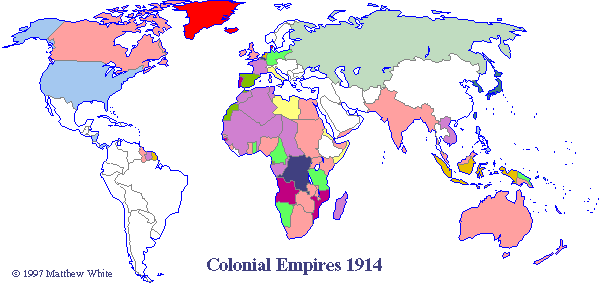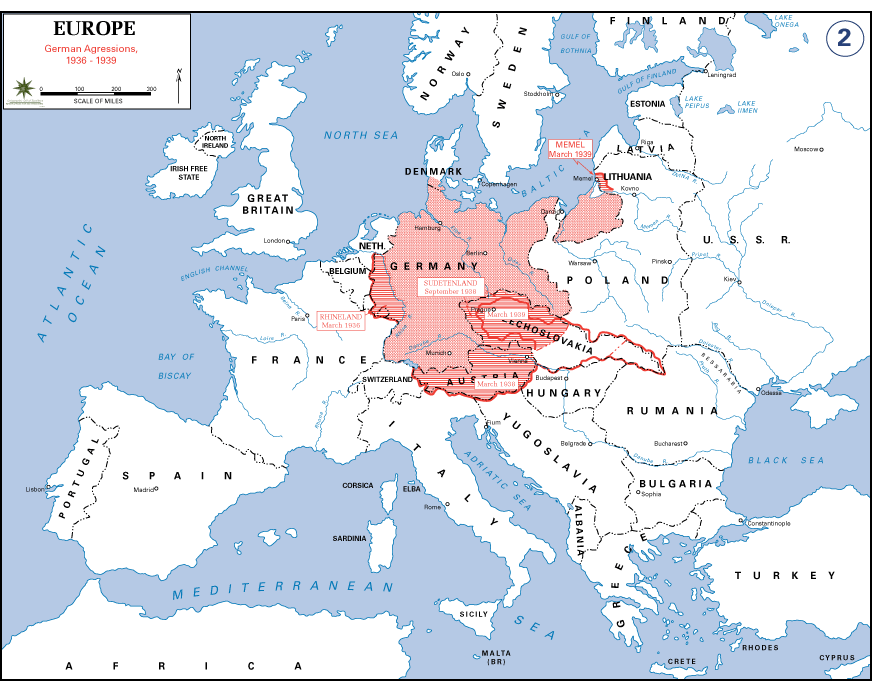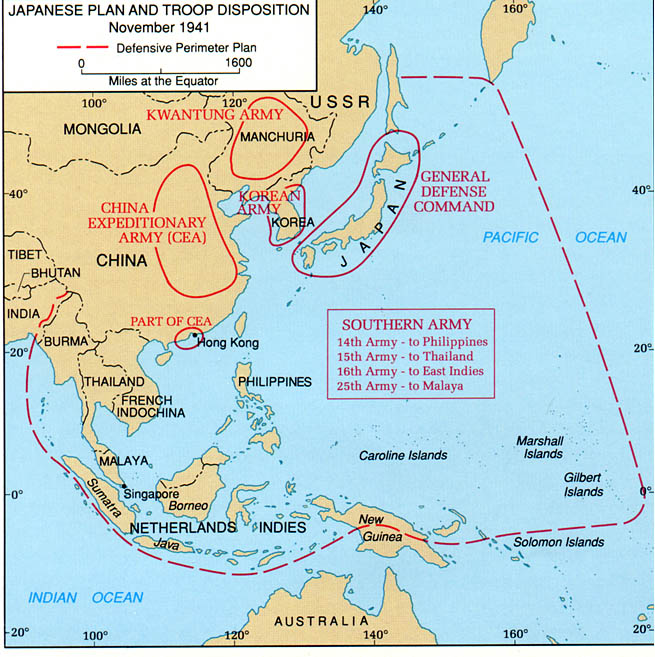History 1700 MacKay
The U.S. as World Power

Readings:
Louisiana Purchase and Continental Expansion
 Animated
image combining maps depicting U.S. territorial growth 1810-1920, as produced in
the 1970 National Atlas.
Animated
image combining maps depicting U.S. territorial growth 1810-1920, as produced in
the 1970 National Atlas.
In a some what overheated editorial on the matter of Texas
annexation in the July and August, 1845, number of the Democratic Review,
a journal which he co-founded in 1837, John L. O'Sullivan coined the potent
phrase "Manifest Destiny" to describe the ongoing
expansionistic activities of the United States of America in its almost 70
years of existence. This was a phrase which both well summed up already held
attitudes and opinions, and pointed to a vast potential which would be acted
out in, in a variety of forms and manners, to the present.
The concept of
Manifest Destiny, in its most
fundamental meaning propounds the notion that the United States has a national
destiny determined by divine appointment, which it is the sacred duty of the
nation, through its leaders, to make manifest, to make real. It is shot
through with religious imagery, in particular as related to the historical
experience of the people Israel, and often expressed in terms of an
"advent" or coming, and an "epiphany" or showing forth.
Manifest Destiny thus became the historical stage directions for the
future of the United States.
In functional terms, the concept of Manifest Destiny,
in the first instance, explained and justified those decisions and actions
which had already taken place, and, in the second instance, provided an
ongoing impetus to continue and intensify such decisions in the future. As
such, it was an expression of what intellectual historians style the double
function of ideas in historical action. Because of its breadth, Manifest
Destiny was from the very beginning, a type of "omnibus idea" an
idea which could contain a wide variety of concepts without fear of
contradiction or confusion.
In more detail, Manifest Destiny
is an idea
constructed on the premise that the United States is God's chosen nation and
people, chosen is a singular manner which separates it from any other nation
or people who might conceive such an idea. It is through this
construction that the United States becomes as historical paraphrase of the
people Israel, a new chosen people, a "last chance" for the entire
whole of humanity which is thus called upon to learn from and follow this
nation.
The United States is the largest overseas territorial power in
the world today, with over four million subjects. It currently governs Puerto
Rico, the Virgin Islands, Guam, the Northern Marianas, and American Samoa, and
has "special responsibilities" for the Federated States of Micronesia,
the Marshall Islands and Palau.
U.S. Imperialism
During the late nineteenth and early twentieth centuries, the
United States pursued an aggressive policy of expansionism, extending its
political and economic influence around the globe. Consult this summary used in K12
classrooms: http://www.smplanet.com/imperialism/toc.html
Chronology
-- U.S. Imperialism
1898 Spanish-American War. Treaty of
Paris gives U.S. control of Philippines, Guam, Puerto Rico.
U.S. annexes Hawaii
1899-1902 American-Filipino War
1899-1900 U.S. pursues "Open Door" policy toward
China
1900 U.S. annexes Puerto Rico. U.S. and
other imperial powers put down Chinese Boxer Rebellion
1901 U.S. forces Cuba to adopt constitution favorable to U.S.
interests
1903 Hay--Bunau-Varillia Treaty signed, giving U.S. control of
Panama Canal Zone
1904 "Roosevelt Corollary" to Monroe Doctrine
proclaimed
1905 Roosevelt negotiates end to Russo-Japanese War
1906-1917 U.S. intervenes in Cuba, Nicaragua, Haiti, Dominican
Republic, and Mexico
1910 Mexican revolution
1914 Panama Canal Opens
1914 U.S. invades Mexico
 In the Philippine War, over 16,000 Filipino soldiers died and it
is estimated that close to 200,000 Filipino civilians lost their lives as well.
Some 5,000 American soldiers died.
(National Museum of Health and Medicine)
In the Philippine War, over 16,000 Filipino soldiers died and it
is estimated that close to 200,000 Filipino civilians lost their lives as well.
Some 5,000 American soldiers died.
(National Museum of Health and Medicine)
U.S. Imperialism, 1900

(http://pages.uoregon.edu/kimball/ggr.frn.MPR.gnr.htm)
World War I


(Source:
http://users.erols.com/mwhite28/1907powr.htm)
In countless ways, World War I created the fundamental elements of 20th
century history. Genocide emerged as an act of war. So did the use of poison
gas on the battlefield. The international system was totally transformed. On
the political right fascism came out of the war; on the left a communist
movement emerged backed by the Soviet Union. America became a world
power. The British Empire reached its high point and started to unravel.
Britain never recovered from the shock of war, and started her decline to
the ranks of the second-class powers. At the peace conference of 1919, the
German, Turkish, and Austro-Hungarian empires were broken up. New boundaries
were drawn in Europe and the Middle East, boundaries -- as in Iraq and
Kuwait -- which were still intact at the end of the century.
Just as the war was ending, German Nationalists like Hitler gathered
millions who rejected the peace and blamed Jews and Communists for their
defeat. The road to the Second World War started there.
Chronology -- Clash of Empires
1914 World War One is triggered by the assassination of
Archduke Ferdinand
1915 Lusitanian sunk
1917 Germany resumes unrestricted submarine warfare. U.S.
declares war on Germany
1917 U.S. purchases Virgin Islands from Denmark
1917 Russian Revolution
11-11-1918 Treaty of Versailles,
Wilson's 14 Points
World War II

http://www.dean.usma.edu/history/web03/atlases/ww2%20europe/ww2%20europe%20pages/ww2%20europe%20map%2002.htm
 1880
1880
 1920
1920
In 1919, the British and French implemented the 1916 Sykes-Picot Agreement and
divided the Arab world into nation-states. The League of Nations recognized
these borders and allotted "mandates" to the French and British to govern these
states until it was determined that they were ready for independence. (http://www.pbs.org/wgbh/globalconnections/mideast/maps/poltext.htm)

http://www.reisenett.no/map_collection/historical/Asia_1941.jpg
Chronology
1931-32 Japan seizes Manchuria
1933 Hitler becomes German chancellor
1936 Spanish Civil War
1939 Germany invades Poland; World War Two begins
1941 Germany attacks USSR; Japan attacks U.S. at Pearl Harbor;
U.S. declares war
1944 Normandy invasion
1945 Hiroshima and Nagasaki Bombed by U.S.; Japan
surrenders
Causes of World War II
- The economic collapse, and the political
instability caused by World War I led the rise of fascism in Europe to World
War II. The Nazi version of fascism was dedicated to the reversal of the
Versailles Treaty and the establishment of a German Empire by means of war and
conquest.
- The Great Depression decimated the economies of
Europe and the United States. This was fertile ground for the emergence of the
Nazis to power in Germany, and a military clique to take power in Japan. In
the United States and in western Europe, the pre-occupation with the domestic
economic crisis contributed to the political failure to meet the rising threat
of fascism.
- Fascism was an ideology which glorified the military, denounced
international organizations and cooperation, and considered war an acceptable
means for achieving national goals. Hitler's Germany and Mussolini's Italy
adopted aggressive foreign policies involving war as an intended, even
desirable method.
- England pursued a determined effort to avoid war, which played into
Hitler's plans because he used every concession to prepare the stage for his
next demand. France consistently followed England's lead. The English and the
French did not trust Stalinist Russia, and Stalin distrusted the capitalist
West. When the Russians tried to form a common front against fascism in the
1930's, many English and French leaders considered Nazi Germany to be useful
as a check against Russian expansion.
- The United States, as the leading power in the
world after World War I, might have exercised great influence in restoring a
stable peace through economic assistance to war torn Europe, and through an
active role in the League of Nations, discouraged aggression. Failure to do that
led to the rise of fascism and the path to renewed war.

The Cold War
The Union of Soviet Socialist
Republics (USSR) was founded in 1922 with four republics. By its
dissolution in 1991, it was a confederation of 15 republics. The
Russian Soviet Federated Socialist Republic (SFSR) was by far
the largest of the union republics, spanning two continents.
Other republics--called Soviet Socialist Republics (SSRs)--were
located in Central Asia, Transcaucasia, Eastern Europe, and the
Baltics. The 15 union republics are now independent countries.
(Source:
http://encarta.msn.com/media_461540279/Union_of_Soviet_Socialist_Republics.html)
http://commons.wikimedia.org/wiki/Image:Cold_War_Map_1959.png

http://commons.wikimedia.org/wiki/Image:Cold_War_Map_1980.png
The cold war began with mistrust between the Soviet Union and the
western democracies as early as the Russian Revolution. The Soviet
Union felt it had good cause to mistrust the West.
- In 1919 the former World War I allies of Britain, France and
the United States joined the "White Russians" to fight off the
Bolsheviks following the revolution. (For more information see
The
American Invasion of Russia). Although this intervention
failed and the Red Army of the Bolsheviks secured the power of the
new Soviet state, the young USSR government never quite trusted
the western democracies after that.
- The western democracies did not invite the Soviet Union to
participate in the World War I peace talks or the League of
Nations.
- The west did not aid the Republicans fighting the fascists in
the Spanish Civil War.
- The west did not invite the Soviets to the Munich Conference
which decided the fate of Czechoslovakia in the years leading up
to World War II, even though the Soviet Union had a security pact
with Czechoslovakia.
The West, for its part, never trusted the Soviet Union:
- The avowed purpose of the International Communist Party to secure
world wide communist revolution. There was a great fear of
socialism in Europe and America.
- The Soviets negotiated an agreement with Hitler and annexed
eastern Poland.
- By the end of the war Britain and the United States distrusted
the Soviet motives in eastern Europe.
This mutual distrust was barely suppressed during World War II
when for practical reasons (the common enemy of Hitler's Germany)
the western allies and the Soviet Union became uneasy allies. Stalin believed that the western allies were dragging their feet
in opening up the "second front" in Europe, so necessary to take the
pressure off the struggling Soviet forces in the east.
Stalin was open about wanting "friendly governments" in Eastern
Europe to protect his country's western frontier from another
invasion like the invasion by Germany.
(Source: The Cold War Museum:
http://www.historywiz.com/coldwarexhibit.htm) |
Chronology
1946 Winston Churchill's "Iron Curtain" speech
1947 Truman Doctrine
1948 Marshall Plan; Berlin airlift
1949 NATO;; first USSSR atomic bomb; Communist victory in
China
1950 Joseph McCarthy's first charges; outbreak of Korean War
1953 Armistice in Korea
1954 Vietnamese victory over French in Dien Bien Phu; McCarthy
hearings
1947: The Truman Doctrine.
1949: NATO Treaty signed.
1949: Communists take power in China; Nationalists retreat to Taiwan
1950: Korean War begins.
1953: Armistice ends fighting in the Korean War.
1955: Warsaw Pact is formed
1961: Bay of Pigs invasion.

http://blog.richmond.edu/livesofmaps/files/2013/11/Map-28.2-Cold-War-Confrontation1.jpg
Toward Peaceful Coexistence
1962: Cuban Missile Crisis.
1964: Gulf of Tonkin Resolution.
1965: President Johnson begins escalation of US role in Vietnamese Civil War.
1972: US withdraws from Vietnam.
1972: SALT Treaty signed
1972: Nixon visits China
1973: U.S. begins pull out of troops in Vietnam
1979: The Soviet Union invades Afghanistan
1985: Gorbachev begins policy of "Perestroika"
1989: The Fall of the Berlin Wall; The Cold War ends.
1989: Tiananmen Square Massacre in China


 In the Philippine War, over 16,000 Filipino soldiers died and it
is estimated that close to 200,000 Filipino civilians lost their lives as well.
Some 5,000 American soldiers died.
(National Museum of Health and Medicine)
In the Philippine War, over 16,000 Filipino soldiers died and it
is estimated that close to 200,000 Filipino civilians lost their lives as well.
Some 5,000 American soldiers died.
(National Museum of Health and Medicine)


 1880
1880
 1920
1920


